2008 MERCEDES-BENZ E-CLASS ESTATE fold seats
[x] Cancel search: fold seatsPage 55 of 401
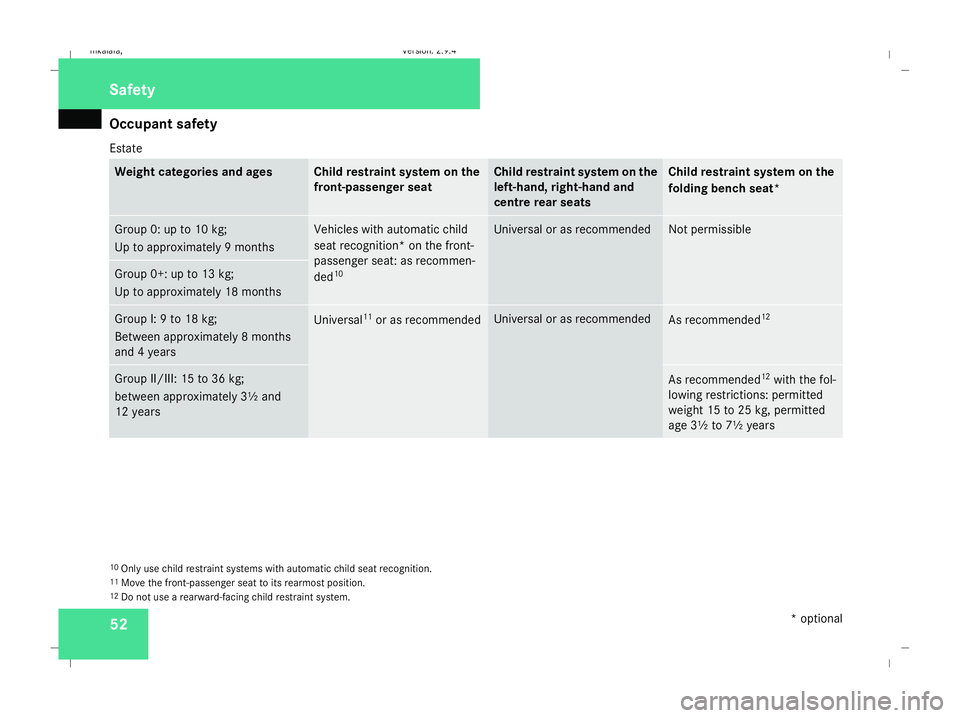
Occupant safety
52
Estate Weight categories and ages Child restraint system on the
front-passenger seat Child restraint system on the
left-hand, right-hand and
centre rear seats Child restraint system on the
folding bench seat*
Group 0: up to 10 kg;
Up to approximately 9 months Vehicles with automatic child
seat recognition* on the front-
passenger seat: as recommen-
ded 10 Universal or as recommended Not permissible
Group 0+: up to 13 kg;
Up to approximately 18 months
Group I: 9 to 18 kg;
Between approximately 8 months
and 4 years Universal
11
or as recommended Universal or as recommended
As recommended
12 Group II/III: 15 to 36 kg;
between approximately 3½ and
12 years As recommended
12
with the fol-
lowing restrictions: permitted
weight 15 to 25 kg, permitted
age 3½ to 7½ years 10
Only use child restraint systems with automatic child seat recognition.
11 Move the front-passenger seat to its rearmost position.
12 Do not use a rearward-facing child restraint system. Safety
* optional
211_AKB; 2; 5, en-GB
mkalafa,
Version: 2.9.4 2008-02-29T16:57:07+01:00 - Seite 52Dateiname: 6515_3416_02_buchblock.pdf; preflight
Page 80 of 401
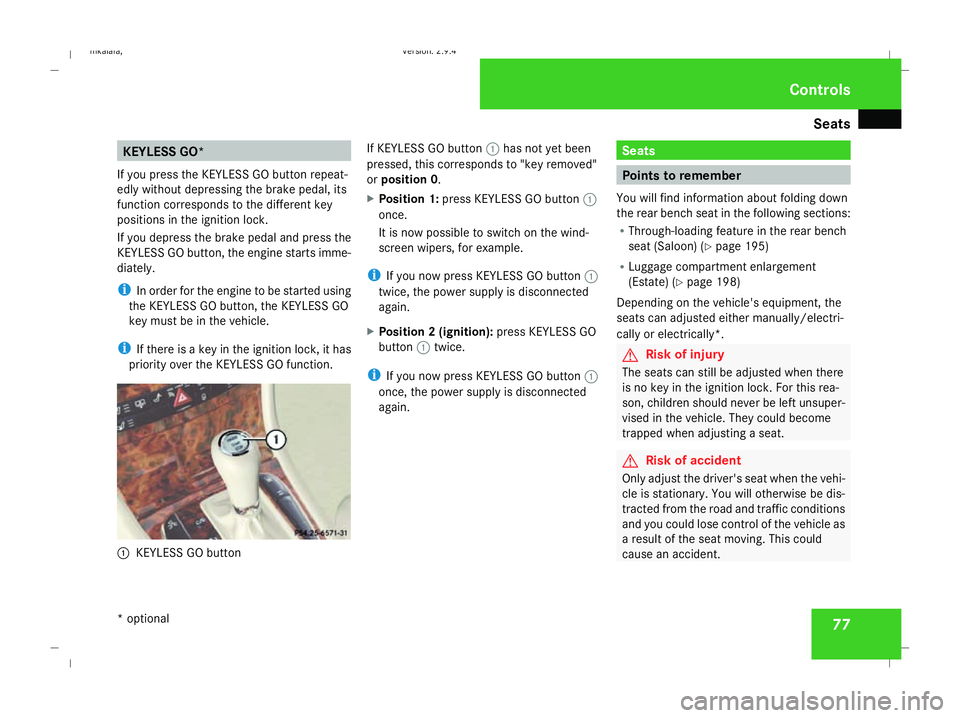
Seats
77KEYLESS GO*
If you press the KEYLESS GO button repeat-
edly without depressing the brake pedal, its
function corresponds to the different key
positions in the ignition lock.
If you depress the brake pedal and press the
KEYLESS GO button, the engine starts imme-
diately.
i In order for the engine to be started using
the KEYLESS GO button, the KEYLESS GO
key must be in the vehicle.
i If there is a key in the ignition lock, it has
priority over the KEYLESS GO function. 1
KEYLESS GO button If KEYLESS GO button
1has not yet been
pressed, this corresponds to "key removed"
or position 0.
X Position 1: press KEYLESS GO button 1
once.
It is now possible to switch on the wind-
screen wipers, for example.
i If you now press KEYLESS GO button 1
twice, the power supply is disconnected
again.
X Position 2 (ignition): press KEYLESS GO
button 1twice.
i If you now press KEYLESS GO button 1
once, the power supply is disconnected
again. Seats
Points to remember
You will find information about folding down
the rear bench seat in the following sections:
R Through-loading feature in the rear bench
seat (Saloon) (Y page 195)
R Luggage compartment enlargement
(Estate) (Y page 198)
Depending on the vehicle's equipment, the
seats can adjusted either manually/electri-
cally or electrically*. G
Risk of injury
The seats can still be adjusted when there
is no key in the ignition lock. For this rea-
son, children should never be left unsuper-
vised in the vehicle. They could become
trapped when adjusting a seat. G
Risk of accident
Only adjust the driver's seat when the vehi-
cle is stationary. You will otherwise be dis-
tracted from the road and traffic conditions
and you could lose control of the vehicle as
a result of the seat moving. This could
cause an accident. Controls
* optional
211_AKB; 2; 5, en-GB
mkalafa, Version: 2.9.4 2008-02-29T16:57:07+01:00 - Seite 77 ZDateiname: 6515_3416_02_buchblock.pdf; preflight
Page 82 of 401
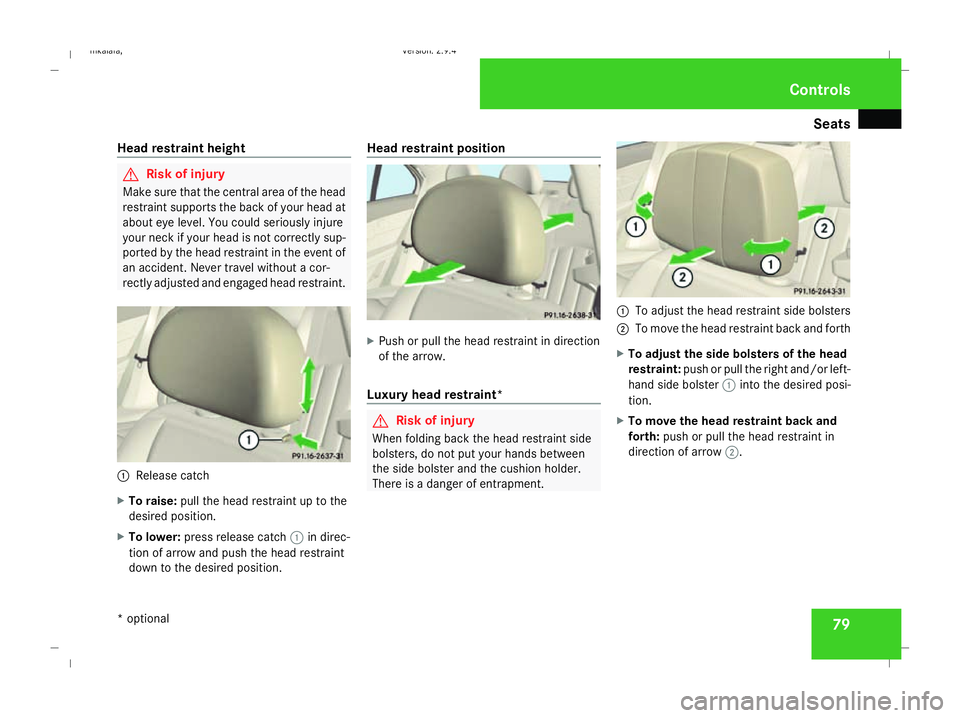
Seats
79
Head restraint height G
Risk of injury
Make sure that the central area of the head
restraint supports the back of your head at
about eye level. You could seriously injure
your neck if your head is not correctly sup-
ported by the head restraint in the event of
an accident. Never travel without a cor-
rectly adjusted and engaged head restraint. 1
Release catch
X To raise: pull the head restraint up to the
desired position.
X To lower: press release catch 1in direc-
tion of arrow and push the head restraint
down to the desired position. Head restraint position
X
Push or pull the head restraint in direction
of the arrow.
Luxury head restraint* G
Risk of injury
When folding back the head restraint side
bolsters, do not put your hands between
the side bolster and the cushion holder.
There is a danger of entrapment. 1
To adjust the head restraint side bolsters
2 To move the head restraint back and forth
X To adjust the side bolsters of the head
restraint: push or pull the right and/or left-
hand side bolster 1into the desired posi-
tion.
X To move the head restraint back and
forth: push or pull the head restraint in
direction of arrow 2. Controls
* optional
211_AKB; 2; 5, en-GB
mkalafa,
Version: 2.9.4 2008-02-29T16:57:07+01:00 - Seite 79 ZDateiname: 6515_3416_02_buchblock.pdf; preflight
Page 83 of 401
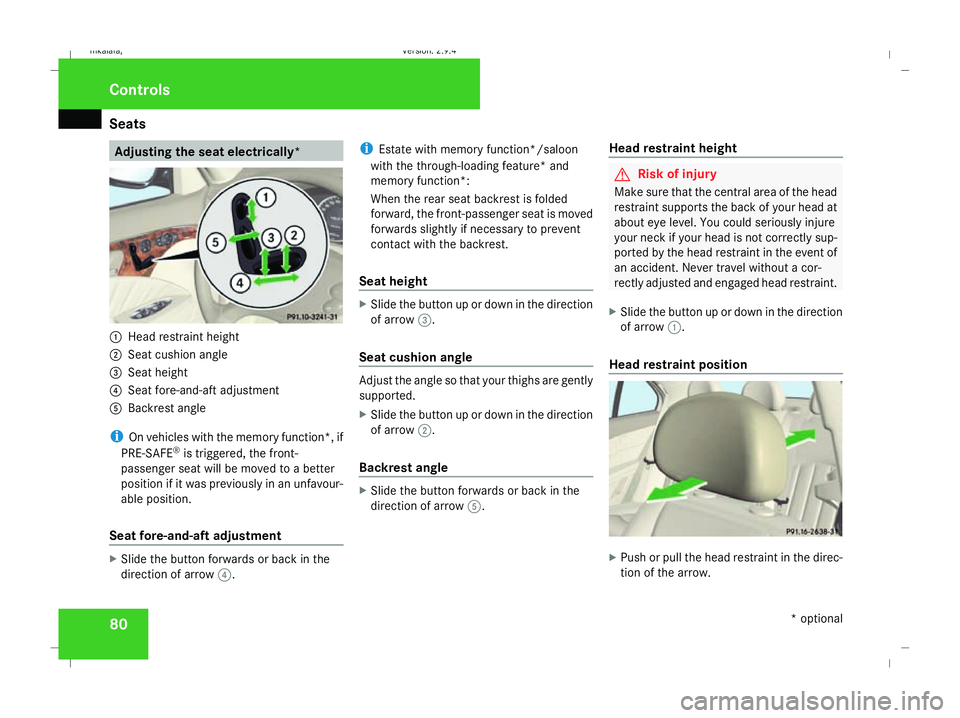
Seats
80 Adjusting the seat electrically*
1
Head restraint height
2 Seat cushion angle
3 Seat height
4 Seat fore-and-aft adjustment
5 Backrest angle
i On vehicles with the memory function*, if
PRE-SAFE ®
is triggered, the front-
passenger seat will be moved to a better
position if it was previously in an unfavour-
able position.
Seat fore-and-aft adjustment X
Slide the button forwards or back in the
direction of arrow 4. i
Estate with memory function*/saloon
with the through-loading feature* and
memory function*:
When the rear seat backrest is folded
forward, the front-passenger seat is moved
forwards slightly if necessary to prevent
contact with the backrest.
Seat height X
Slide the button up or down in the direction
of arrow 3.
Seat cushion angle Adjust the angle so that your thighs are gently
supported.
X
Slide the button up or down in the direction
of arrow 2.
Backrest angle X
Slide the button forwards or back in the
direction of arrow 5. Head restraint height G
Risk of injury
Make sure that the central area of the head
restraint supports the back of your head at
about eye level. You could seriously injure
your neck if your head is not correctly sup-
ported by the head restraint in the event of
an accident. Never travel without a cor-
rectly adjusted and engaged head restraint.
X Slide the button up or down in the direction
of arrow 1.
Head restraint position X
Push or pull the head restraint in the direc-
tion of the arrow. Controls
* optional
211_AKB; 2; 5, en-GB
mkalafa,
Version: 2.9.4 2008-02-29T16:57:07+01:00 - Seite 80Dateiname: 6515_3416_02_buchblock.pdf; preflight
Page 84 of 401
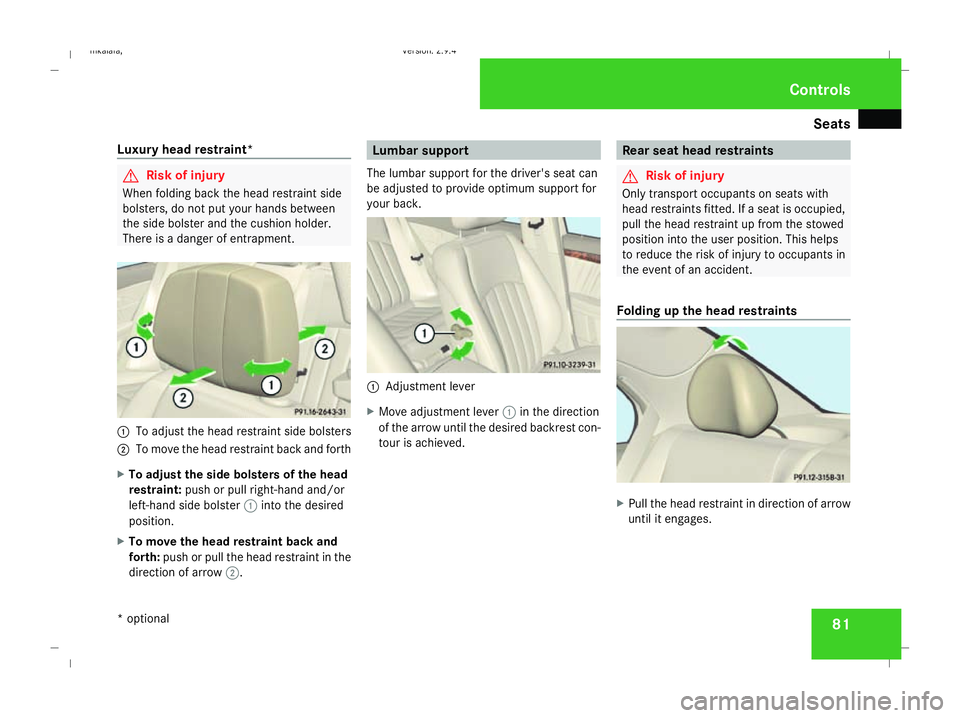
Seats
81
Luxury head restraint* G
Risk of injury
When folding back the head restraint side
bolsters, do not put your hands between
the side bolster and the cushion holder.
There is a danger of entrapment. 1
To adjust the head restraint side bolsters
2 To move the head restraint back and forth
X To adjust the side bolsters of the head
restraint: push or pull right-hand and/or
left-hand side bolster 1into the desired
position.
X To move the head restraint back and
forth: push or pull the head restraint in the
direction of arrow 2. Lumbar support
The lumbar support for the driver's seat can
be adjusted to provide optimum support for
your back. 1
Adjustment lever
X Move adjustment lever 1in the direction
of the arrow until the desired backrest con-
tour is achieved. Rear seat head restraints
G
Risk of injury
Only transport occupants on seats with
head restraints fitted. If a seat is occupied,
pull the head restraint up from the stowed
position into the user position. This helps
to reduce the risk of injury to occupants in
the event of an accident.
Folding up the head restraints X
Pull the head restraint in direction of arrow
until it engages. Controls
* optional
211_AKB; 2; 5, en-GB
mkalafa,
Version: 2.9.4 2008-02-29T16:57:07+01:00 - Seite 81 ZDateiname: 6515_3416_02_buchblock.pdf; preflight
Page 85 of 401
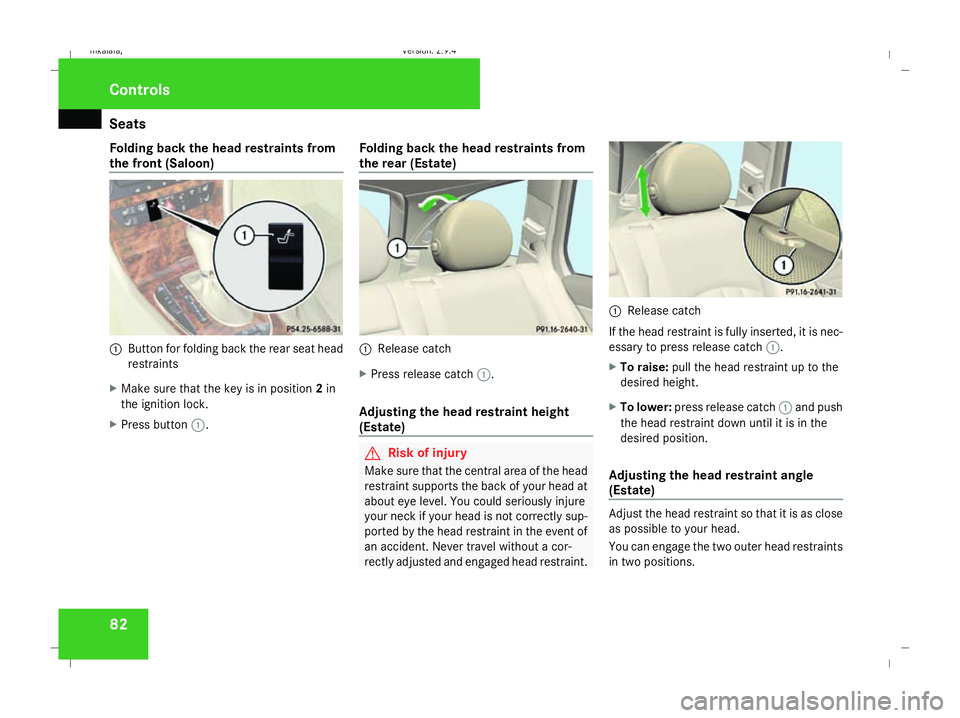
Seats
82
Folding back the head restraints from
the front (Saloon) 1
Button for folding back the rear seat head
restraints
X Make sure that the key is in position 2in
the ignition lock.
X Press button 1. Folding back the head restraints from
the rear (Estate) 1
Release catch
X Press release catch 1.
Adjusting the head restraint height
(Estate) G
Risk of injury
Make sure that the central area of the head
restraint supports the back of your head at
about eye level. You could seriously injure
your neck if your head is not correctly sup-
ported by the head restraint in the event of
an accident. Never travel without a cor-
rectly adjusted and engaged head restraint. 1
Release catch
If the head restraint is fully inserted, it is nec-
essary to press release catch 1.
X To raise: pull the head restraint up to the
desired height.
X To lower: press release catch 1and push
the head restraint down until it is in the
desired position.
Adjusting the head restraint angle
(Estate) Adjust the head restraint so that it is as close
as possible to your head.
You can engage the two outer head restraints
in two positions.Controls
211_AKB; 2; 5, en-GB
mkalafa,
Version: 2.9.4 2008-02-29T16:57:07+01:00 - Seite 82Dateiname: 6515_3416_02_buchblock.pdf; preflight
Page 86 of 401
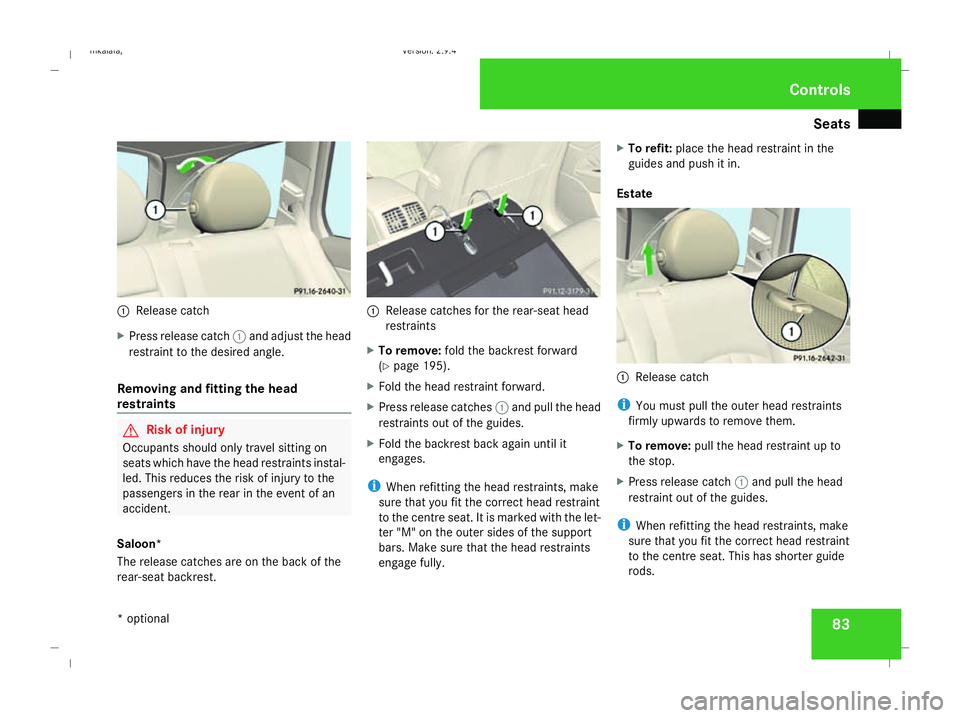
Seats
831
Release catch
X Press release catch 1and adjust the head
restraint to the desired angle.
Removing and fitting the head
restraints G
Risk of injury
Occupants should only travel sitting on
seats which have the head restraints instal-
led. This reduces the risk of injury to the
passengers in the rear in the event of an
accident.
Saloon*
The release catches are on the back of the
rear-seat backrest. 1
Release catches for the rear-seat head
restraints
X To remove: fold the backrest forward
(Y page 195).
X Fold the head restraint forward.
X Press release catches 1and pull the head
restraints out of the guides.
X Fold the backrest back again until it
engages.
i When refitting the head restraints, make
sure that you fit the correct head restraint
to the centre seat. It is marked with the let-
ter "M" on the outer sides of the support
bars. Make sure that the head restraints
engage fully. X
To refit: place the head restraint in the
guides and push it in.
Estate 1
Release catch
i You must pull the outer head restraints
firmly upwards to remove them.
X To remove: pull the head restraint up to
the stop.
X Press release catch 1and pull the head
restraint out of the guides.
i When refitting the head restraints, make
sure that you fit the correct head restraint
to the centre seat. This has shorter guide
rods. Controls
* optional
211_AKB; 2; 5, en-GB
mkalafa,
Version: 2.9.4 2008-02-29T16:57:07+01:00 - Seite 83 ZDateiname: 6515_3416_02_buchblock.pdf; preflight
Page 89 of 401
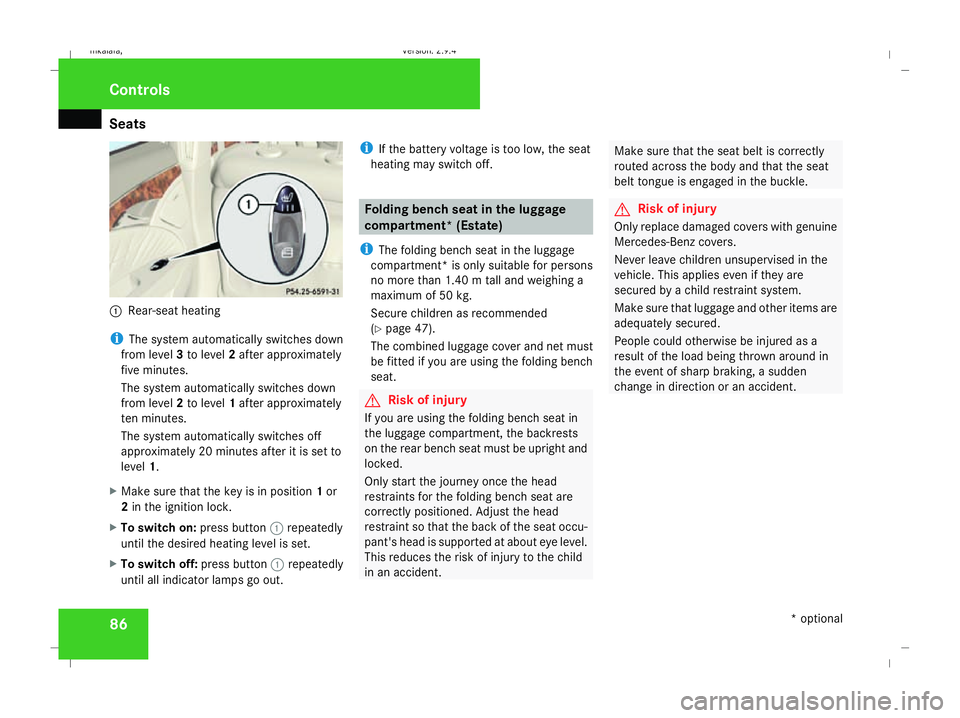
Seats
861
Rear-seat heating
i The system automatically switches down
from level 3to level 2after approximately
five minutes.
The system automatically switches down
from level 2to level 1after approximately
ten minutes.
The system automatically switches off
approximately 20 minutes after it is set to
level 1.
X Make sure that the key is in position 1or
2 in the ignition lock.
X To switch on: press button1repeatedly
until the desired heating level is set.
X To switch off: press button1repeatedly
until all indicator lamps go out. i
If the battery voltage is too low, the seat
heating may switch off. Folding bench seat in the luggage
compartment* (Estate)
i The folding bench seat in the luggage
compartment* is only suitable for persons
no more than 1.40 m tall and weighing a
maximum of 50 kg.
Secure children as recommended
(Y page 47).
The combined luggage cover and net must
be fitted if you are using the folding bench
seat. G
Risk of injury
If you are using the folding bench seat in
the luggage compartment, the backrests
on the rear bench seat must be upright and
locked.
Only start the journey once the head
restraints for the folding bench seat are
correctly positioned. Adjust the head
restraint so that the back of the seat occu-
pant's head is supported at about eye level.
This reduces the risk of injury to the child
in an accident. Make sure that the seat belt is correctly
routed across the body and that the seat
belt tongue is engaged in the buckle. G
Risk of injury
Only replace damaged covers with genuine
Mercedes-Benz covers.
Never leave children unsupervised in the
vehicle. This applies even if they are
secured by a child restraint system.
Make sure that luggage and other items are
adequately secured.
People could otherwise be injured as a
result of the load being thrown around in
the event of sharp braking, a sudden
change in direction or an accident. Controls
* optional
211_AKB; 2; 5, en-GB
mkalafa,
Version: 2.9.4 2008-02-29T16:57:07+01:00 - Seite 86Dateiname: 6515_3416_02_buchblock.pdf; preflight